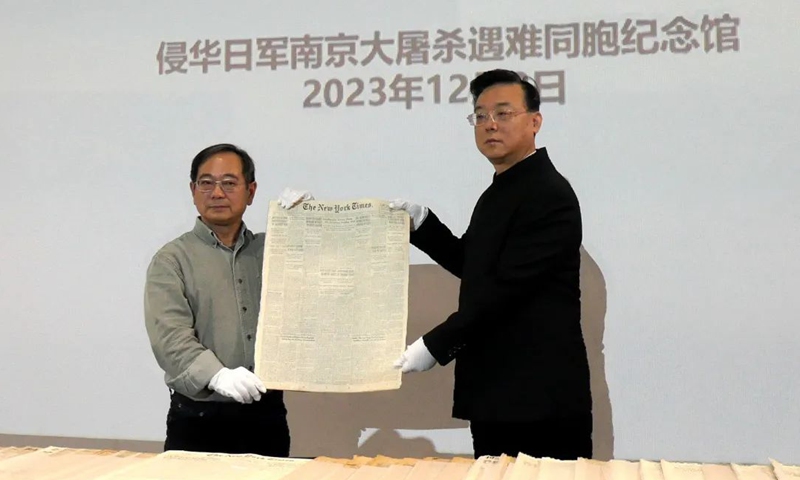
Lu Zhaoning (left) donates a US newspaper to the Memorial Hall of the Victims in Nanjing Massacre by Japanese Invaders. Photo: He Pengfei
The Memorial Hall of the Victims in Nanjing Massacre by Japanese Invaders announced Saturday that a series of new historical materials showing the downright barbaric violence by invading Japanese troops will be unveiled, ahead of the upcoming 10th National Memorial Day for the Victims of the Nanjing Massacre on Wednesday.
A total of 1,103 historical materials related to the Nanjing Massacre have been collected by the memorial hall, including an army journal and 125 US newspapers donated by an American-Chinese named Lu Zhaoning.
The journal details the mass crimes committed by Japanese troops such as rape, looting and mass mutilation of Chinese soldiers from August 1937 to December of the same year.
Far from the personal journals of Japanese officers, the army journal is a military document that objectively documents the main activities of the forces that the reporter was following, according to Wang Weixing, a researcher at the East China's Jiangsu Provincial Academy of Social Sciences, adding that the journal's details can further reveal Japanese troops' crimes during the Nanjing Massacre.
Starting from December 13, 1937, Japanese troops' occupation of Nanjing lasted six weeks. They slaughtered more than 300,000 Chinese civilians and unarmed soldiers in one of the most barbaric episodes of World War II. The massacre is considered to be one of the worst wartime atrocities.
Other historical materials include Japanese military files detailing the capture of Nanjing such as orders and routes. Meanwhile, the US newspapers, such as The New York Times, Chicago Tribune and St. Louis Post-Dispatch, record the violence perpetrated by Japanese troops in Nanjing and Western countries' reaction.
These documents mark the first time that US newspapers covered "The hundred man killing contest" and have prominent historical and exhibition value, Yang Xiaming, a professor of the Party School of the Communist Party of China (CPC) Jiangsu Committee, said.
On January 25, 1938, The New York Times had a front-page story reporting on the lasting chaos after the Japanese army occupied Nanjing, while on September 11, 1937 and July 29, 1939, respectively, two French newspapers published photographs of Japanese planes bombing Shanghai and Chinese policemen searching for corpses in the rubble, according to the Xinhua News Agency.
To date, the Memorial Hall of the Victims in Nanjing Massacre by Japanese Invaders has more than 193,000 items in its collection.
Zhou Feng, curator of the memorial hall, underscored the significance of in-depth research into the historical materials related to the Nanjing Massacre.
"The memorial hall will continue to enhance the international dissemination of the Nanjing Massacre archives as part of the Memory of the World Register and strengthen the revitalization and utilization of cultural relics and historical materials," he said.




